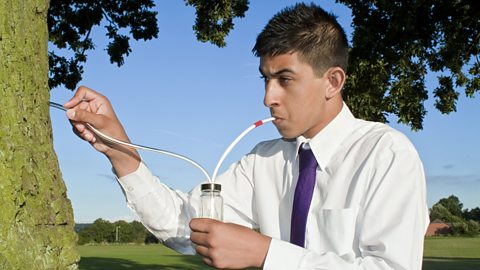Scientific method
Science aims to develop a good explanation of natural events (phenomena) that are observed.
Scientists use the scientific method to develop explanations. This follows a specific way of working:
- propose a hypothesisA starting point for investigation. An idea or explanation to be tested., which is an initial theory or explanation for an observation
- make a predictionA suggestion, based on a hypothesis of how a factor will affect an outcome. based on the hypothesis, suggesting how changing one factor will affect the observation or outcome
- plan an experiment to test the prediction and the hypothesis on which it is based
Planning experiments
It is important to choose appropriate apparatus, materials and techniques.

A pooter is a safe way to collect insects for study
Apparatus
Containers include:
- boiling tubes
- beakers
- water baths
- sweep nets
- pooterDevice used in ecological sampling to collect insects.
Measuring apparatus include:
- timers
- rulers
- quadratA square frame of known area used for sampling the abundance and distribution of slow or non-moving organisms.
- thermometerAn instrument used to measure temperature.
- pipettes
- measuring cylinders
- microscopes
- pH meters
Biological apparatus include:
- Petri dishA type of flat, circular dish with a lid. containing agar jellyA gel made from algae, which provides an ideal growth medium. or other growth media
- antibioticSubstance that controls the spread of bacteria in the body by killing them or stopping them reproducing. or antisepticA substance that kills or stops the growth of germs which cause disease. solutions
- food tests
- plant seedlings or lengths of pondweed
Chemicals for analysis include:
- indicatorA substance that has different colours, depending upon the pH of the solution it is in., such as universal indicatorA chemical solution that produces many different colour changes corresponding to different pH levels., litmus, phenolphthalein and methyl orange
- substances for chemical tests, such as limewaterCalcium hydroxide solution. It turns milky in the presence of carbon dioxide. to test for carbon dioxide, iodine solution to test for starch and Benedict's solutionA solution that can be used to test for the presence of a reducing sugar (or the presence of an aldehyde group). to test for glucose
Techniques
Standard techniques of measurement. The table gives some examples.
| Apparatus | Measures |
| Thermometer | Temperature |
| pH meter | pH |
| Timer | Time |
| Digital balance | Mass |
| Measuring cylinder | Volume of liquid |
| Burette | Volume of liquid in titration |
| Gas syringe | Volume of gas |
| Apparatus | Thermometer |
|---|---|
| Measures | Temperature |
| Apparatus | pH meter |
|---|---|
| Measures | pH |
| Apparatus | Timer |
|---|---|
| Measures | Time |
| Apparatus | Digital balance |
|---|---|
| Measures | Mass |
| Apparatus | Measuring cylinder |
|---|---|
| Measures | Volume of liquid |
| Apparatus | Burette |
|---|---|
| Measures | Volume of liquid in titration |
| Apparatus | Gas syringe |
|---|---|
| Measures | Volume of gas |
Biological experimental methods include:
- using a light microscope
- aseptic techniquesName given to the laboratory procedures carried out to prevent the contamination of pure cultures of microorganisms. during microbiological experiments to measure the effect of antibiotics and antiseptics
- measuring increases or decreases in mass of plant tissue after osmosisThe movement of water molecules across a selectively permeable membrane from a region of higher water concentration to a region of lower water concentration.
- testing the efficiency of enzymes at different temperatures or pHs
- food tests
- comparing the rate of photosynthesisA chemical process used by plants to make glucose and oxygen from carbon dioxide and water, using light energy. Oxygen is produced as a by-product of photosynthesis. Algae subsumed within plants and some bacteria are also photosynthetic. at different light intensities
- measuring reaction times
- determining the effect of light on plant growth
- measuring the population size of a common speciesA type of organism that is the basic unit of classification. Individuals of different species are not able to interbreed successfully. in a habitatA place where plants, animals and microorganisms live.
- comparing the effect of an abiotic factor on the distribution of this species